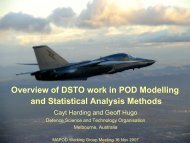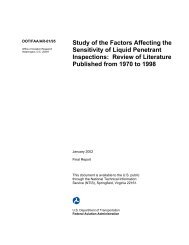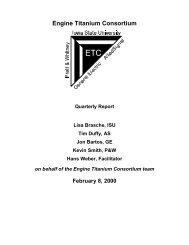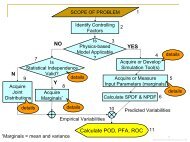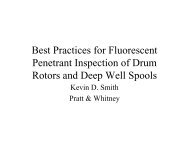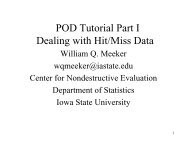Engine Titanium Consortium - Center for Nondestructive Evaluation ...
Engine Titanium Consortium - Center for Nondestructive Evaluation ...
Engine Titanium Consortium - Center for Nondestructive Evaluation ...
You also want an ePaper? Increase the reach of your titles
YUMPU automatically turns print PDFs into web optimized ePapers that Google loves.
Peak> Range of Ave. Range of Peak<br />
GE: 0.81% 2.03% 0.2% - 1.9% 0.5% - 6.1%<br />
PW: 0.83% 2.31% 0.4% - 1.8% 0.7% - 5.5%<br />
HW: 0.88% 2.36% 0.4% - 2.5% 0.6% - 6.9%<br />
(#1 FBH in Ti 6-4 = 100%)<br />
Table 1. Comparison of average and maximum gated-peak noise voltages seen in the suites of<br />
coupons from the GE, P&W, and HW <strong>for</strong>gings. The first two columns list the average and<br />
maximum values <strong>for</strong> a given <strong>for</strong>ging, averaged over all coupons, inspection directions, and analysis<br />
quadrants. The last two columns list the ranges of measured values <strong>for</strong> average and peak noise in<br />
each <strong>for</strong>ging.<br />
Table 2. Comparison of UT properties <strong>for</strong> the high-noise coupons from the Pratt&Whitney, General<br />
Electric, and Honeywell Ti 6-4 <strong>for</strong>gings.<br />
Noise Curvature Blocks<br />
PW GE HW<br />
velocity (cm/usec): 0.622 0.618 0.621<br />
density (gm/cc): 4.43 4.43 4.43<br />
attenuation power law * : 6.83E-4*freq^1.79 4.31E-5*freq^2.26 8.20E-4*freq^1.34<br />
attenuation at 10 MHz: 0.93 dB/inch 0.17 dB/inch 0.40 dB/inch<br />
FOM power law * : 1.61E-3*freq^1.25 2.95E-3*freq^0.896 4.15E-3*freq^1.078<br />
Meas. FOM at 10 MHz: 0.027 0.021 0.047<br />
* For power laws, units are N/cm <strong>for</strong> attenuation, and<br />
cm^-0.5 <strong>for</strong> FOM, with the frequency input in MHz.<br />
Six “noise curvature blocks” were made to investigate the manner in which surface curvature<br />
influences inspection sensitivity in <strong>for</strong>gings. A principal use of the blocks will be to test models that<br />
predict the characteristics of backscattered grain seen during <strong>for</strong>ging inspections. The six blocks,<br />
each measuring approximately 1.6” x 5.9” x 2” (axial x radial x hoop) were fabricated by<br />
Pratt&Whitney from one of their Ti 6-4 <strong>for</strong>gings. The location of each block within the <strong>for</strong>ging<br />
cross-section is shown in Figure 8a. For five of the blocks, the upper surface in Figure 10a is<br />
curved, while the sixth block has a flat upper surface. Although each block was cut from the same<br />
position in the radial/axial plane of the <strong>for</strong>ging, the blocks, of necessity, had different angular<br />
positions, as shown in Figure 8b. Since microstructural variations in the hoop direction of a <strong>for</strong>ging<br />
are often minor, it was hoped that this construction method would produce six blocks with nearly<br />
identical microstructures.<br />
Quarterly Report – January 1, 2002 –March 31, 2002<br />
print date/time: 6/6/2002 - 8:39 AM – Page 42








